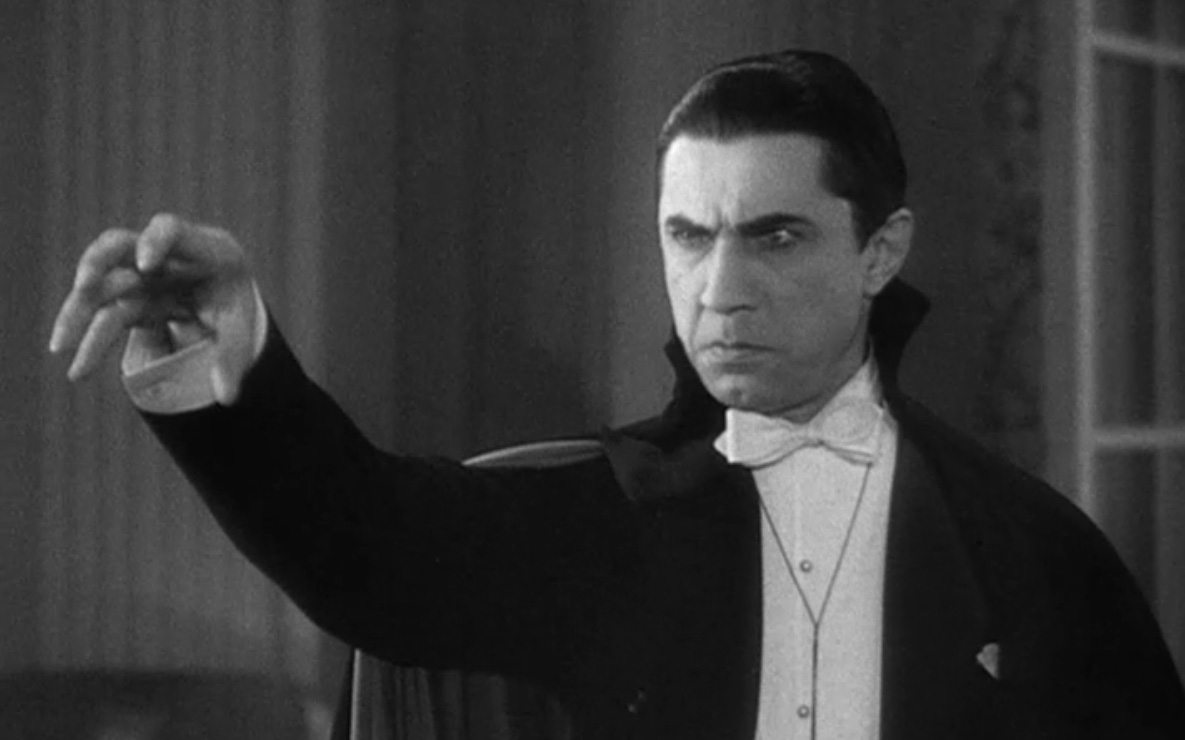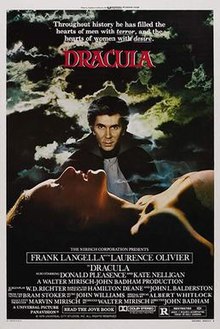
Dracula. One of the most iconic horror villains of all time. Originally appearing in the 1897 novel Dracula by Bram Stoker, there have been many movies, television shows, video games, books and even pinball machines and musicals based on the character. Let's take a look at where it all started with the Dracula movies made by Universal Studios. Note, this will only cover those movies where Dracula is the only villain. The monster mash-ups of the 1940s will be covered separately.


First we have Dracula (1931) directed by Tod Browning. This is the first official Dracula film. After the success of Phantom of the Opera (1925), Universal Studios were hoping to capitalise on another successful horror franchise. They chose the best-selling novel Dracula as a source material (although the film is actually closer to the stage production by Hamilton Deane and John Balderston).
Plot: I presume most of you are familiar with the story of Dracula but for those that aren't here is a brief summary. Renfield (Dwight Frye) is a solicitor who has been tasked with visiting Count Dracula (Béla Lugosi) to arrange for the count to buy Carfax Abbey in London. On his way there, Renfield has some strange encounters. The locals seem terrified of the count and urge Renfield to go home. A strange carriage appears to take him to the castle and is later seen being driven by a bat. At the castle, Renfield is attacked by Dracula and becomes a madman, obsessed with eating insects. Upon their return to England, Renfield is committed to Dr. Seward's (Herbert Bunston) sanitorium. Meanwhile, Dracula becomes friends with Dr. Seward's daughter Mina (Helen Chandler), her fiancé John Harker (David Manners) and friend Lucy (Frances Dade). Lucy becomes fascinated by Dracula, but when she turns up dead the following day, with strange bite marks in her neck, the family call in Professor Van Helsing (Edward Van Sloan) to get to the bottom of the mystery.
My thoughts: It's a good film. Very 1930s feel to it. Lugosi is wonderful as Dracula, helped by his thick Hungarian accent and his prior experience playing the character in the Deane and Balderston play. Lugosi's portrayal of Dracula set the standard and pretty much everyone has copied him to this day. The best performance, however, is that given by Dwight Frye, who was so good at playing a madman you could be fooled into thinking he wasn't acting. The female characters were typical 1930s female characters and Manners does a competent job as Harker. The only thing I don't like about this film is Van Sloan as Van Helsing. He just comes off as smug and he loves it when he knows something the others don't, even going as far as mocking Dracula himself about it as seen in the trailer. Anyway, we now move onto to a movie which is effectively a remake...

My thoughts: It's a good film. Very 1930s feel to it. Lugosi is wonderful as Dracula, helped by his thick Hungarian accent and his prior experience playing the character in the Deane and Balderston play. Lugosi's portrayal of Dracula set the standard and pretty much everyone has copied him to this day. The best performance, however, is that given by Dwight Frye, who was so good at playing a madman you could be fooled into thinking he wasn't acting. The female characters were typical 1930s female characters and Manners does a competent job as Harker. The only thing I don't like about this film is Van Sloan as Van Helsing. He just comes off as smug and he loves it when he knows something the others don't, even going as far as mocking Dracula himself about it as seen in the trailer. Anyway, we now move onto to a movie which is effectively a remake...

Made at the same time as the previous film this time in Spanish. At the time, French, Spanish, Italian and German versions were made of the big films but unfortunately, most of them are lost. In fact, this one was believed lost until a copy was found in the 1970s.
Plot: This film's plot is exactly the same as the previous film's
My thoughts: The crew were able to watch the English-language version being filmed and they spent their time figuring out how to make theirs better and some believe they succeeded. It certainly is more atmospheric but I still prefer the American one. It might be because Carlos Villarias doesn't look like Dracula, especially when he smiles. He looks goofy to me. Anyway, you should check it out as it is available on DVD with English subtitles.



Dracula was followed by a sequel in 1936 Dracula's Daughter directed by Lambert Hillyer. This would be the only Dracula film from Universal not to feature Dracula himself (although his corpse does make a brief appearance).
Plot: Taking place immediately after the events of Dracula, Van Helsing has been arrested and charged with the murder of Count Dracula. Instead of hiring a lawyer, Van Helsing hires a former student of his, Dr. Jeffrey Garth (Otto Kruger), a psychiatrist. Meanwhile, Count Dracula's daughter, the Countess Maria Zeleska (Gloria Holden) and her manservant Sandor (Irving Pichel), have stolen Dracula's body and plans to burn it in an attempt to free Maria from the curse of vampirism. It doesn't work. But when Maria meets Dr. Garth, she is filled with a renewed hope that the doctor's science can help. Unfortunately, Sandor is in no hurry to see Maria cured.
My thoughts: Good movie. More creative and thought-provoking than Dracula. Probably why it didn't perform very well at the box office. I guess people didn't like the idea of a vampire being portrayed in a sympathetic manner. Also, the implied lesbian overtones are very apparent and who doesn't like lesbian suckers? Worth checking out.

Dracula's Daughter was followed by another sequel in 1943, Son of Dracula (not to be confused with a 1974 film with the same title starring Leslie Nielsen). By this point, Universal were struggling to get audiences interested in their horror films, a lot of patrons believed horror was just a passing fad. As a result, Universal churned out many low quality horror flicks and this one is no exception.
Plot: The film is set on a New Orleans plantation when a mysterious stranger, the Hungarian Count Alucard (read it backwards) (Lon Chaney, jr.) turns up, invited by Katherine Caldwell (Louise Allbritton), daughter of a wealthy plantation owner Colonel Caldwell (George Irving). Shortly after this, the colonel dies of heart failure and leaves his possessions to his two daughters: Claire (Evelyn Ankers) receives his money and Katherine receives the estate. Katherine marries Alucard, something that her boyfriend Frank Stanley (Robert Paige) is none too pleased about. He shoots Alucard in anger, but the bullets (somehow) go through his body and hit Katherine who is standing behind him. Frank is understandably distraught and seeks his friends Dr. Brewster (Frank Craven) and Professor Laszlo (J. Edward Bromberg) for advice. Together they realise that Alucard and Katherine are not what they seem and what follows is a very confusing tale of immortality.
My thoughts: This movie is confusing. Mainly because it can't make up it's mind if Alucard is Dracula or not. Hell, just look at the title. No explanation is given as to how Dracula survived having his corpse burned in Daughter of Dracula, nor why a seemingly Hungarian count has an American accent. Not much to say about this although it is the first movie to feature an on-screen vampire-to-bat transformation scene (previous movies had the transformation occur off-screen) and it is the only movie where Chaney played Dracula (he has also played the Wolf Man, Frankenstein's Monster and the Mummy in various other Universal movies). Check it out if you're curious otherwise, I wouldn't bother.


After the 1940s, Universal branched away from horror and never really went back to it. However, after The Exorcist (1973), Texas Chain Saw Massacre (1974) and Jaws (1975), revived interest in the American horror film, they decided to bring back one their most successful characters with a modern remake in 1979 directed by John Badham.
Plot: The film is set in 1913 Whitby when Count Dracula (Frank Langella) is washed ashore after his ship runs aground. Mina (Jan Francis) is on her way to visit her friend Lucy (Kate Nelligan) when she stumbles across a bedraggled Dracula. Dracula later visits Mina and Lucy at Lucy's house, where he meets her father Dr. Jack Seward (Donald Pleasence) and her fiancé Jonathan Harker (Trevor Eve). The following morning, Mina is found dead with throat wounds. This causes the Sewards to contact Mina's father, Professor Abraham Van Helsing (Laurence Olivier) who is convinced his daughter has become the victim of a vampire. Meanwhile, Lucy finds herself falling in love with the mysterious Count Dracula, much to the chagrin of Harker. The rest of the movie is the typical Dracula story.
My thoughts: In my opinion this is the best version of Dracula. A lot people say Bram Stoker's Dracula is the best, but I think this one's better. All the actors play their parts well (Olivier does sometimes go over the top however) and the film overall is very atmospheric. Even the romance element is done well. The big changes made to story were the Lucy and Mina characters being swapped over, Mina being Van Helsing's daughter and the character of Renfield being largely removed. Definitely check it out.
So far, those have been the only Dracula movies Universal have made. Many other Dracula films have been made, most notably the ones made by British studio Hammer Films. We'll look at those later. Next, the other big hit for Universal: "It's alive! It's alive!!! IT'S ALIVE!!!!!!".
See also:
More horror
Nosferatu
See also:
More horror
Nosferatu
